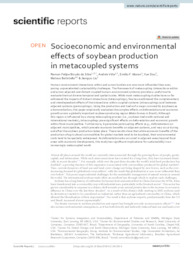Socioeconomic and environmental effects of soybean production in metacoupled systems.
Socioeconomic and environmental effects of soybean production in metacoupled systems.
Autoria: SILVA, R. F. B. da; VIÑA, A.; MORAN, E. F.; DOU, Y.; BATISTELLA, M.; LIU, J.
Resumo: Abstract. Human-environment interactions within and across borders are now more influential than ever, posing unprecedented sustainability challenges. The framework of metacoupling (interactions within and across adjacent and distant coupled human-environment systems) provides a useful tool to evaluate them at diverse temporal and spatial scales. While most metacoupling studies have so far addressed the impacts of distant interactions (telecouplings), few have addressed the complementary and interdependent effects of the interactions within coupled systems (intracouplings) and between adjacent systems (pericouplings). Using the production and trade of a major commodity (soybean) as a demonstration, this paper empirically evaluates the complex effects on deforestation and economic growth across a globally important soybean producing region (Mato Grosso in Brazil). Although this region is influenced by a strong telecoupling process (i.e., soybean trade with national and international markets), intracouplings pose significant effects on deforestation and economic growth within focal municipalities. Furthermore, it generates pericoupling effects (e.g., deforestation) on adjacent municipalities, which precede economic benefits on adjacent systems, and may occur during and after the soybean production takes place. These results show that while economic benefits of the production of agricultural commodities for global markets tend to be localized, their environmental costs tend to be spatially widespread. As deforestation also occurred in adjacent areas beyond focal areas with economic development, this study has significant implications for sustainability in an increasingly metacoupled world.
Ano de publicação: 2021
Tipo de publicação: Artigo de periódico
Unidade: Embrapa Agricultura Digital
Observações
1 - Por padrão são exibidas publicações dos últimos 20 anos. Para encontrar publicações mais antigas, configure o filtro ano de publicação, colocando o ano a partir do qual você deseja encontrar publicações. O filtro está na coluna da esquerda na busca acima.
2 - Para ler algumas publicações da Embrapa (apenas as que estão em formato ePub), é necessário ter, no celular ou computador, um desses softwares gratuitos. Sistemas Android: Google Play Livros; IOS: iBooks; Windows e Linux: software Calibre.
Acesse outras publicações
Acesse a Base de Dados da Pesquisa Agropecuária (BDPA) para consultar o acervo completo das bibliotecas da Embrapa.

